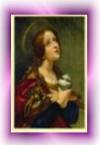St. John of Egypt is also known as John the Hermit or John the Anchorite. He was one of the Hermits of the Nitrean desert. He began as a carpenter, and after receiving a divine calling, he let and set out for solitude. According to hagiographer Alban Butler, John was noted for performing seemingly absurd acts at the biding of the Holy Spirit, such as rolling rocks from place to place, and cultivating dead trees. He then withdrew to the top of a cliff, where he could avoid all human contact.
To avoid temptation, he avoided seeing women in particular, and most men. He avoided all people the last fifty years of his life. St. Augustine wrote that John was tempted by devils and performed miraculous cures. He cured a woman, according to St. Augustine, of blindness. He then appeared to her in a vision, to avoid seeing her in person with his own eyes, to avoid temptation. He possessed the spiritual gift of prophecy and spoke through a window to people twice a week from his hermitage. He predicted future victories to the Emperor Theodosius the Great.
According to Butler, John prayed incessantly, and he spent the majority of his day in prayer. The last three days of his life he went without food or water, and without any outside interactions remaining only in prayer. When he was discovered, he was in his cell on bended knee in prayer – deceased. His feast day is March 27th.
St. John of Egypt
Moderators: Johnna, MarieT, Denise, KarlB
St. John of Egypt
Devotion to the souls in Purgatory contains in itself all the works of mercy, which supernaturalized by a spirit of faith, should merit us Heaven. de Sales
Re: St. John of Egypt
remarkable
Studying the desert fathers - very interesting
Studying the desert fathers - very interesting
"He who followeth Me, walketh not in darkness." sayeth the Lord
